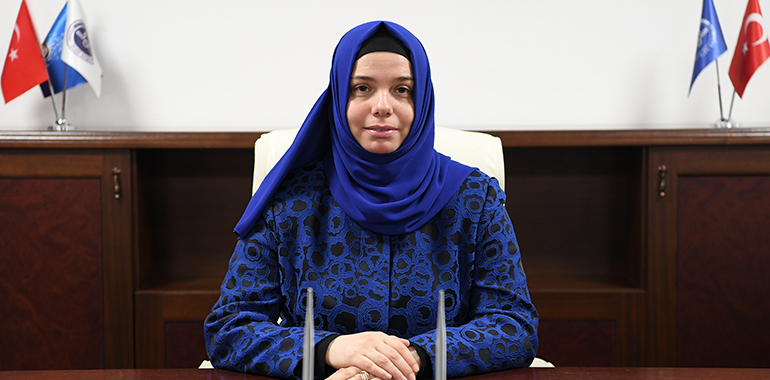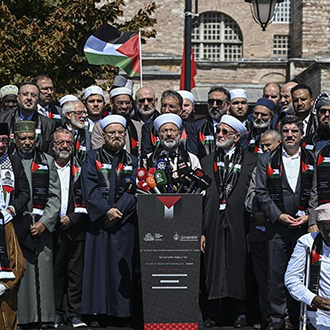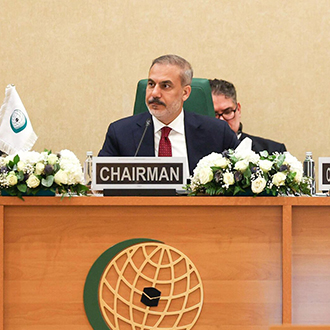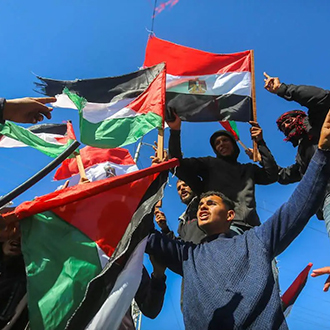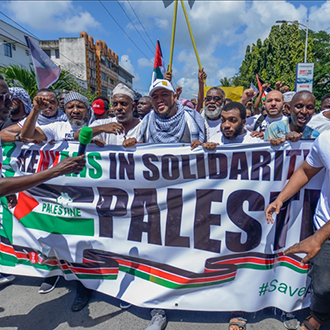Huriye Martı was born in Ankara in 1974. After graduating from the Faculty of Theology at Selçuk University, she received her M.A. degree from the same university in 1998 with her thesis titled “The Evaluation of the Narrations of the Messenger of Allah on the Subject of Women - Fabricated Narrations on the Subject of Women”. Subsequently, she completed her Ph.D. degree from the Faculty of Theology at Selçuk University in 2005 with her thesis titled “Muhammad Birgivi’s Character as a Hadith Scholar and al-Tariqat al-Muhammadiyah (Investigation and Analysis)”. Between 1999 and 2000, she studied at Shuaib Al-Arna’ut’s Center for Tahqiq and Takhrij in Amman, Jordan. She became an assistant professor in 2011, an associate professor in 2012, and a professor in 2017. She served as an editor and author for the Thematic Hadith Project published by the Presidency of Religious Affairs under the title ‘Islam through Hadiths’. She was appointed as the Head of the Family and Religious Counseling Department of the Presidency of Religious Affairs in 2011, as the Counselor of the Presidency of Religious Affairs in 2014, and as the Vice President of the Presidency of Religious Affairs in 2017. Martı, renowned as a prolific scholar, has authored numerous articles, conducted many conferences, and published extensive papers focusing on women from the perspectives of sunnah, family, ethics, and values.
In contemporary discourse, the evaluation of any concept related to ‘Women,’ whether it be women in Islam, working women, or women in social life, often becomes intricate and susceptible to misinterpretation. How should we interpret the wisdom of the prominence of the subject of “Islam and Human” in the Qur’an and hadiths, and how should we analyze today’s life in this sense?
The discussion of issues related to women should be rooted in authentic knowledge derived from verses and hadiths. This foundation is established by defining a woman as a ‘human being’—the honorable caliph of the earth. We are all aware of the serious misconceptions that arise as a result of considering Islam’s perception of women separately from its perception of human beings. A view and belief that has positioned women against men rather than alongside them since their first steps in the world have seen women as a pendulum oscillation trying to drag men in the opposite direction of the truth. In other words, this belief constructed men and women as two different beings moving in opposite directions and thus in constant opposition and tension. However, the Qur’an and the authentic hadiths point out that men and women are only two different ends of the same pendulum (i.e. human reality) and that they offer each other a new possibility of movement through their mutual oscillation.
Men and women have the potential to create new goodness by complementing each other, due to their inherent differences. They are equal in being created with such potential. Therefore, when women create their own spaces with their unique feelings, thoughts, talents, and experiences, they lead men into a world of meaning whose boundaries cannot be clearly defined and offer them the opportunity to perceive themselves and then life itself from a new perspective.
In this context, the Messenger of Allah, the honorable remarker of the hadiths, did not ascribe an unprecedentedly high value to women but only revived and supported their ability to be “caliphs”. The Messenger of Allah (saw) removed the obstacles to women’s self[1]expression and paved the way for them to reflect their intrinsic value as human beings in society.
The prophetic attitude wants everyone to realize that women, as the other dimension of human existence that oscillates like a pendulum, can show humanity different aspects of the truth through their unique insights, discoveries, and experiences and thus assume their own responsibility. If the essence of human existence is perpetual action and movement, then women, as the other end of this action and movement, acquire their own identity and character. This is the point that the Prophet (saw) wants people to see: It is only through the movement of the other end of the pendulum that both genders can form their own movements, actions, and identities. A perception that alienates and antagonizes men or oppresses and humiliates women—in short, a perception that degrades the human being—does nothing but disrupt the movement of the pendulum, that is, hinders humanity’s activity of goodness and reconstruction on earth. For the sake of a world worth living in and a Hereafter in which there is hope of salvation, it is imperative that all ideas and actions toward women be based on justice, mercy, respect, and affection, which is exactly what human beings deserve.
We can see that Islam has reconstructed the negative perception of women that had developed under the shadow of ancient traditions, distorted religions, and cultural conceptions. In this context, can you explain the position and reputation that women have gained with Islam in terms of the value of women?
In a picture as old as history, it is possible to see the traces of indecision about what color could symbolize the value of women. The period in which the Prophet Muhammad (saw) lived, both before and after, witnessed perhaps the sharpest color transformations in this picture. The main reason for this is that in the teachings of the new and final religion, women had a wider and deeper sphere of existence than before. In other words, a long period in which women, although ontologically accepted within the concept of the human being, were positioned at a lower level in economic, cultural, and political terms that had not yet reached the competence of men, came to an end with the Prophet of Islam.
The material and spiritual benefits to women of the changes brought about by the Prophet (saw) can be analyzed in detail. However, the question of what level of consciousness-raising lies at the basis of these benefits, in other words, which basic thought pattern determines the new position of women in society, needs to be answered first. The importance of this question is not limited to the determination of the arrangements in daily life that allowed women to breathe but is perhaps more related to the “value” debates that continue to rage today. To put it briefly, does the elevation of women’s status stem from the idea that they are inherently “valuable”? Did women gain value due to religion, or did they have the opportunity to uncover the value that already existed in their own being? If we take a step back and ask again, did the Prophet Muhammad give women a value that did not exist before, or did he introduce society to “women who derived their value from their own womanhood”?
Our opinion, based on countless examples, is that the Messenger of Allah (saw) does not focus on “sexes” but on “human beings”. He does not have two separate and special approaches to women or men; he has an approach to human beings. As a natural consequence, he does not give value to women through men. On the contrary, he recognizes, sees, and shows the value that women derive from their own existence and brings into this world as “the noblest of creatures”.
As in every aspect of life, the Messenger of Allah acted in the light of the revelation concerning women. Allah the Almighty, who did not mention any gender when He said to His angels, “I am going to place a successive ‘human’ authority on earth” (Baqarah, 2:30) and when He said that He “placed humans as successors on earth” (Naml, 27:62; Fatir, 35:39), attributes the honor and responsibility of being a caliph to both the men and the women. Therefore, it is clear that the mentality that says that men can be caliphs but women can only be deputy caliphs at best is not based on the verses of Allah the Almighty.
In the words of the Almighty Creator, men and women are like a veil or a garment that compensates for each other’s shortcomings and covers and protects each other (Baqarah, 2:187). These two souls, who deserve the same reward when they do a good deed (Al-i ‘Imran, 3:195) and the same punishment when they commit a mistake (Ma‘idah, 5:38; Nur 24:2), are too similar to be ahead of each other in representing the human concept.
Islam not only recognized women as ontologically equal to men, but also drew attention to their potential to achieve a similar position to men on cultural, political, economic, and social levels. From this point of view, the Prophet’s attitudes, which present the value of women to the minds, actually revitalize and develop their ability to become “caliphs”. Stating that the children of Adam and Hawwa did not have the possibility of gaining superiority in the eyes of their Lord through their race, language, and color, the Prophet (saw) said: “O people, your Lord is One, and your father is one. An Arab has no superiority over a non-Arab nor does a non[1]Arab has any superiority over an Arab; also a white has no superiority over a black nor a black has any superiority over a white except by piety and good action. The noblest of you in Allah’s sight is the most pious.” (Ibn Hanbal, Musnad, V/411) Therefore, he (saw) does not make a distinction between the sexes but rather points out the inherent responsibility of each individual to behave in a manner that befits human dignity and the right to be valued as a human being. Consequently, both the measures he took to prevent women from being victimized and the rights he granted them to express their existence ultimately reinforce the value of the human being.
How can we exemplify the importance the Prophet (saw) placed on the education of women?
Immediately after the hijrah, the women who came to visit the blessed guest who honored Medina believed that he was the “Messenger of Allah” and pledged allegiance to him with the excitement of faith that had just blossomed in their hearts: “O Messenger of Allah, we give you our pledge that we will not associate anything with Allah, we will not steal, we will not have unlawful sexual relations, we will not utter slander, fabricating from between our hands and feet, and we will not disobey you in goodness.” (Nasa’i, Bay’ah, 18) Our Prophet accepted the pledge of allegiance from the women who came to meet him in groups.
The relationship between women and the mosque began in the Masjid al[1]Nabawi. Women who wished to see their Prophet (saw) and follow his example, to learn religion by listening to his speeches, to ask him questions and give him gifts, and to enjoy the pleasure of worship by forming ranks behind him, took their place among the permanent congregation of the Masjid al-Nabawi. The last Prophet (saw) said: “Verily, I have been sent as a teacher.” (Darimi, Muqaddimah, 32). His message was addressed to all members of society, regardless of their gender, so the masjid, the indispensable place for conveying the divine message, embraced everyone. Thanks to the power of the masjid to bring together, unite, and reconcile, the people of Medina were more peaceful.
In this city that embraced the Prophet and incorporated Islam into its very fabric, neighborhoods, streets, houses, and spouses were nourished from the same source as parts of a magnificent whole. On the one hand, the Prophet strove for them “as if he were grieving himself to death” (Kahf, 18:6), and on the other, the companions listened to him with such reverence and care “as if a bird had landed on their heads” (Ibn Hanbal, IV/278). In order to ensure that no one was deprived of this mobilization of “listening and transformation”, the Messenger of Allah (saw) said, “Do not prevent the maid-servants of Allah from going to the mosque.” (Bukhari, Jumu’ah, 13). Indeed, the message of the Prophet (saw) was very clear: Women are the servants of Allah just like men. The servants are Allah’s, and the masjids are Allah’s. Who would dare interfere with them! Of course, parents and children would respond to the same adhan; they would feel the enthusiasm of the same takbir, the peace of the same qira’ah, and the impact of the same guidance in their souls; and they would achieve unity and peace as a family.
So, can we conclude that the women’s relationship with the mosque during the ‘Asr al-Sa‘adah (Age of Bliss) was very strong and their position in the mosque was very important?
Our Prophet (saw) did not exclude women from his congregation and did not deprive them of the honor of performing prayers behind him and the pleasure of listening to his sermons. In fact, women who complained that they could not be in the mosque as much as they wished due to work, asked, “O, Allah’s Messenger, men receive your instructions; kindly allocate at your convenience a day for us also, on which we would come to you and you would teach us what Allah has taught you.” He gave them special lessons at the times and places they agreed upon (Bukhari, I‘tisam, 9).
The Masjid al-Nabawi was like a nucleus that contained all the codes of Muslim society. There, the Prophet (saw) used to lead the congregation as the imam, listen to those who came to consult him, make decisions on cases, receive official delegations, name the children and pray for them, watch folkloric performances, and make speeches about the problems of the city. Therefore, he (saw) invited women not only to worship but also to be “present” in the most vibrant environment where social life flows.
Do the negatively attributed statements about the role of women in cultural, religious, and family life, falsely attributed to the Prophet Muhammad from the past to the present, impact the discourses surrounding women in the contemporary world? Could you provide a general assessment of this?
The fabricated narrations, which attempt to give a religious guise to negative judgments against women, range from daily advice on how to treat girls to judgments on critical issues such as women’s social status and education. When the narrations are juxtaposed, it is not difficult to see the portrait of women that the mentality that produced them wants to present. Roughly speaking, we are confronted with an image of a woman whose intellectual, ideal, and scientific knowledge is considered inadequate and even unnecessary, whose contribution to the direction of life is not allowed, who is not consulted, and whose skills are not utilized, who is assumed to be untrustworthy and an obstacle to the proper worship of men, and therefore whose living space is restricted, and who is believed to be kept away from education and training.
It is obvious that the evil view that hides behind fabrications does not regard women from the perspective presented by the Prophet (saw). Such a perspective dared to speak against women through the words of the Messenger of Allah and continued its existence in Muslim societies by creating like-minded people with every sentence it fabricated. The image of women whose presence causes discomfort dominates almost all fabrications. As a result, the balance that should have existed between men and women was disturbed in favor of one side, and women, although created with the potential to undertake such a difficult and valuable task as being the caliph on earth, lost even their fundamental rights to live humanely and turned against men. In fact, fabricated narrations that create a negative prejudice against women and foster a relationship that is far from respect, compassion, and trust, position men and women against each other rather than alongside each other. Confining women to domestic life with stagnant preoccupations and limited information actually harms men as much as it harms women. Such a disconnected and value-deprived relationship ignores the fact that the world of meaning of human beings can only be created by men and women together, prevents the two genders from achieving insight and establishing a balanced coexistence by evaluating their differences, and eliminates the possibility of seeing every aspect of life together.



